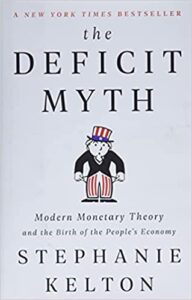MMTers would fight inflation with fiscal austerity

Not long ago, policymakers like Rep. Alexandria Ocasio-Cortez were enamored of something called Modern Monetary Theory (MMT). This theory starts with a banal observation — that a government that issues the currency its debts are denominated in need never (technically) go bankrupt — and, on that basis, argues that we don’t need to worry about the budget deficit. As a leading MMTer, economist Stephanie Kelton, argued in her 2020 book The Deficit Myth: Modern Monetary Theory and the Birth of the People’s Economy:
MMT appealed to many, like AOC, because it seemed to offer the Philosopher’s Stone of economics, the fabled free lunch. But it didn’t.
As Kelton wrote:
Policymakers, then, ought not be looking at the deficit when setting fiscal policy, but at the overall economy – “…the government’s budget isn’t supposed to balance. Our economy is,” Kelton wrote – and to find balance or imbalance in the economy we had to look at the rate of inflation. Kelton explained that:
A deficit is only evidence of overspending if it sparks inflation.
…
Finally, the federal government has historically almost always kept its deficit too small. Yes, too small! Evidence of a deficit that is too small is unemployment. Of course, MMT recognizes that deficits can also be too big. But Senator Enzi had it all wrong. A fiscal deficit isn’t evidence of overspending. For evidence of overspending, we must think of inflation.
But we didn’t need to worry about this. This was, MMTers told us, “the prevailing era of too-low inflation”.
That era is now over. Briefly put, when COVID-19 hit, the federal government borrowed big and the Federal Reserve printed big, using the new money to buy government debt and keep the government’s borrowing costs down. This money was spent into an economy whose capacity to produce the goods and services to spend it on was constrained by shutdowns and other anti-COVID-19 measures. We hit those limits.
Given MMTers had recognized inflation as a problem to be remedied, what did they suggest as the remedy? What would MMTers have been doing these last couple of years if they had been in charge?
Because they thought that we were in an “era of too-low inflation”, MMTers like Kelton spent much more time telling us about all the spending they would do than about how they would deal with the inflation that might arise as a result. But they weren’t silent on the matter. Kelton draws on the work of economist Abba P. Lerner:
To maintain full employment and keep inflation low, Lerner wanted the government to keep constant watch on the economy. If something happened to move the economy out of balance, Lerner wanted to the government to respond with a fiscal adjustment, either changing taxes or altering government spending.
…
If inflation began to creep up, Lerner believed that Congress could respond by raising taxes or cutting back its own expenditures.
In other words, MMTers would fight inflation with fiscal austerity and, presumably, they would deal with high inflation such as we have had recently with particularly strict fiscal austerity.
The Federal budget could certainly use a bit of austerity, but it isn’t clear that it would do very much to fight inflation: how would you get measures like that through Congress? How would fiscal measures fix a monetary problem? Governments in the 1960s and 1970s, when Lerner’s influence was at its peak, did, in fact, use taxes as a tool to fight inflation and with little success because they kept on printing money.
Either way, the free lunch that attracted so many to MMT was never really there. MMTers, in fairness to them, never entirely pretended that it was. One wonders whether AOC still supports MMT now that it dictates fiscal austerity?
John Phelan is an Economist at Center of the American Experiment.

